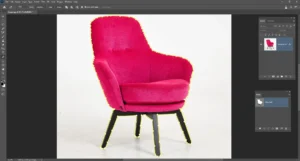Clipping Path in Photoshop
In the world of Photoshop and photo editions, the clipping path service has now become a very popular and familiar name. Both for business products, portrait or event photography, this kind of service is becoming a must nowadays. The photo editing section is spreading bigger and bigger over the course of time. And the clipping path is a very essential part without which editing a photo is quite difficult. Most of the time creating clipping paths is handled by paid professional services as it is not a simple task. Still, we can try to share our knowledge about it so that you can have a better idea of this service.
Clipping Path is the process of creating a path around the outside of an object so that it remains visible when the object is resized or moved. In this Photoshop tutorial for beginners, we’ll show you how to create a clipping path in just a few simple steps.
How to create a smooth EDGE Clipping Path in Photoshop?
Step 1: Launch the Photoshop software. Now open your image which you’d like to create a clipping path for removing the background.
Step 2: First, check all icon palettes in your Photoshop software. If you can’t see the “Path” icon click the window menu in the menu bar. Then click the “Paths”. Now it’s should be visible in your Photoshop area. It’s could help you to create and maintain a clipping path around the subject or image.
Step 3: Select the “Pen Tool (P)” from your main toolbar which should be visible on your left side in Photoshop. You can also select to shortcut by clicking the “P” button on the keyboard.
Step 4: Now click the “Create new path” menu in the “Paths” icon palette. After that, you will have a “Path 1” where you can create a clipping path for any subject or image. Otherwise, you will have a “work path”. I suggest creating it in Path 1 according to my before sentence. Also, you can change the work path to Path 1 by double-clicking on it.
Step 5: Zoom in the photo for a better view. 300% or 400% is the best for creating a smooth clipping path. Here navigator icon palette will help to show the zooming. The Navigator icon palette finds in the window menu.
Step 6: Now start creating or drawing a path around your photos perfectly. The first point should be to start from an easy shape or edge. Continue drawing your path around the whole image edge until you reach the first point. If you need to create another drawing for the same image. Just start again the same as the first step and complete it.
Step 7: Select it after completing creating your path around the subject. Right-click on “Path 1” and hit the make selection option. Now you have a new dialogue box and press the “OK” button with Feather Radius 0.2 or 0.3 pixels. The feather should depend on image resolution. Select it to shortcut by holding on “Ctrl” + click “Path 1” in the paths icon palette.
Step 8: Press the “Layer” menu in the menu bar then there go-to “New” and click on the “Layer via Copy” option. A new layer was created with the image and without the original background in the “Layer” icon palette. But the “Layer” icon palette should be visible. If not, get it from the Window menu the same as other icon palettes.
Step 9: Close your eye to the “Background” layer. Now the image has no background. That means the image has a transparent background. Save it in PNG format if you want without background.
In conclusion, a clipping path is a great way to keep your objects visible when they are resized or moved. We’ve shown you how to do Photoshop Clipping Path Tutorial for beginners, so don’t hesitate to give it a try the next time you need to preserve the boundaries of an object.
For white or any solid color background.
Step 10: Create a new blank layer in the “Layer” palette below Layer 1. Select a solid color from the adjustment layer option and choose the exact color which you want.
Step 11: Save it with Ctrl+Shift+S in your necessary file format.
I hope this article describes to you well how to create a perfect clipping path. But if you have further questions please contact me at info@clippoutline.com





